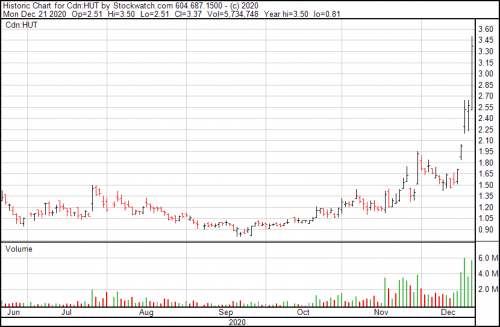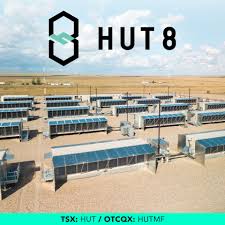It’s been a hell of a year and we can all be glad that it’s almost over. For cryptocurrency, it’s been a year of resurgence and a return to form. Bitcoin specifically had some unusual moments—dipping low at the advent of the pandemic only to soar in the final months—and companies in the peripheral space, offering everything from wallets to mining have gone on for the ride. But in the bitcoin mining space, not all companies are created equal.
To its credit, Hut 8 Mining (HUT.T) isn’t anyone’s idea of a bad company. They have a lot of good things going for them—for example, just this year they were the first cryptocurrency miner to get accepted to the TSX. They had spent a year in the probationary “sandbox” specifically created for companies that may not necessarily meet all of the TSX’s requirements (cryptocurrency miners) but deserve a chance anyway.
But in terms of the risks versus the potential rewards—the scale is heavily skewed towards risk.
The principle problem with this company is that they’re too heavily reliant on one coin—Bitcoin. It’s the right coin to be heavily reliant on because it benefits from the highest visibility, but it is still only one coin. Essentially, it ties the fate of the company to the price of Bitcoin. When it’s doing well, so is the company, but when the ride is over Hut 8 will go down for the count.
The risks here are substantial. Nobody really knows what makes Bitcoin’s price move. It took a hit during COVID-19’s first wave when the Chinese government imposed a lockdown, closing down the majority of Bitcoin mining operations, but fired back up when they were returned to form. Even Hut 8 went on record in saying that they weren’t entirely sure if they were going to be able to stay in business if Bitcoin dipped down below a price-point where it would be profitable for them to remain open.
That unfortunate circumstance never came to pass, but the potentiality remains a factor.
Bitcoin halved this year and the prospect of artificially reduced supply and increased demand could theoretically lead to a new baseline price, which would be good for everyone except the average investor who wants to get in and is priced out of the market. Soon, maybe four, eight or twelve years away, Bitcoin will be available only for institutional investors, if each halving brings about a new baseline. But that’s four years away. Until then we’re going to see unsteady, fluctuating volatility.
The success of a cryptocurrency miner is directly related to its ability to manage its overhead. They possess freshly minted next gen bitcoin miners, but they were late to the halving game losing out on some key profitable months. Eventually, though, they upgraded their entire stock of ASIC-rigs to BlockBox next gen machines and got back onboard. The late to the game effect is reflected in their Q3 highlights below:
- Quarterly revenue of $5.8-million with mining profit margin of negative 37 per cent;
- Revaluation gain related to Hut 8’s bitcoin holdings of $5.6-million for the quarter with a bitcoin price at quarter-end of $10,788 (U.S.);
- Net loss of $900,000 and negative adjusted EBITDA (earnings before interest, taxes, depreciation and amortization) of $2.9-million;
- Renegotiated key terms with lender to provide more downward flexibility with bitcoin collateral and saving Hut 8 nearly $500,000 per year in interest expense;
- Hosting revenue of $500,000 from Hut 8’s first hosting client with six megawatts of latest-generation bitcoin mining equipment;
- Transferred the management of site operations from Bitfury to Hut 8, providing savings of over $1.5-million per year;
- Made a bitcoin equipment order for 275 petahashes per second, of which 154 petahashes per second using 6.7 megawatts were installed this quarter, with the remainder expected to be installed by the end of 2020;
- Hut 8 became the first company to enter and exit the Toronto Stock Exchange Sandbox successfully, which solidifies its place as a TSX issuer.
The second half of the overhead considerations for a company like Hut 8 is air conditioning, and again they have that part covered, at least for most of the year. They’re located in Alberta, Canada, where the cool winds coming down from the Northwest Territories can keep their server-farms cool and operating at peak efficiency for the cold months, and also where they enjoy subsidized electricity.
But the problem with Hut 8 always circles back to their over-reliance on Bitcoin for their entire business model. Most of the other big name cryptocurrency miners, from Riot Blockchain (RIOT.Q), to Hive Blockchain Technologies (HIVE.V), to DMG Blockchain Solutions (DMGI.V) recognize the necessity of a diverse coin-base—with Hive toploading with Ethereum and Ethereum Classic, while Riot has expanded out to include a number of different coins but kept Bitcoin as their bread and butter crypto.
As for an investor’s perspective, the prospect that Hut 8 has made the Canadian big boards may not be enough of a selling point when Bitcoin hits the skids. Let’s look at their chart.

The chart here reflects the positive regard that Bitcoin has accrued over the past six months. It’s price reflects the positive correlation between the rising price of Bitcoin and the concurrent prices of companies operating in its space. But there’s nothing here beyond a knee-jerk reaction to the Bitcoin bull run, which when it ends and the bubble bursts will bring the stock price back to its realistic valuation, and without having anything to fall back on, like Ethereum.
Regardless, Hut’s unfolding story will be an interesting one to watch for 2021.
—Joseph Morton






